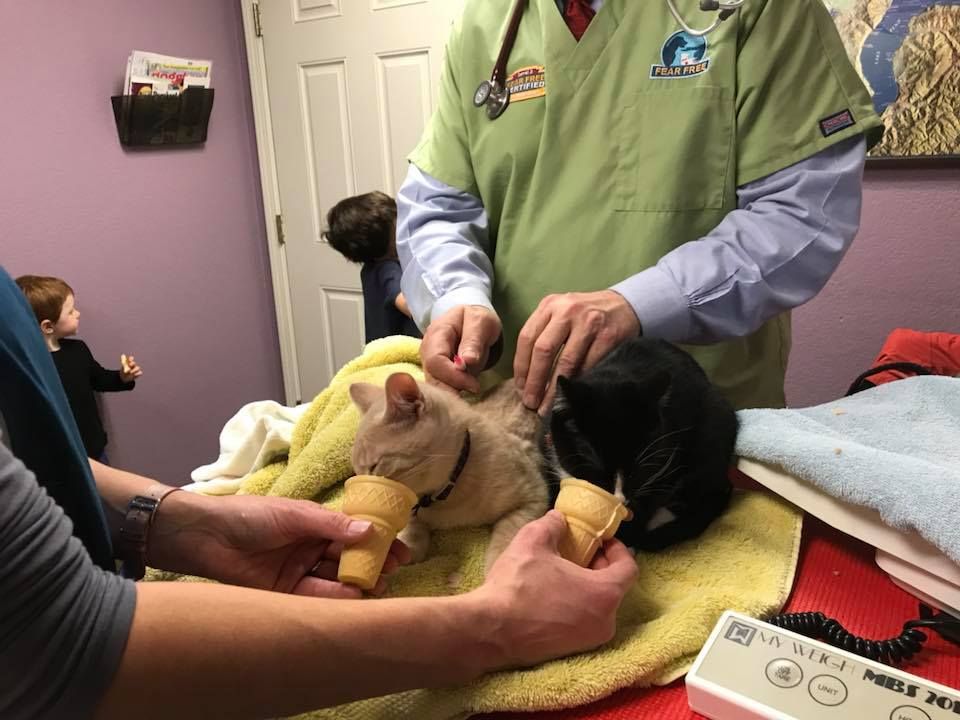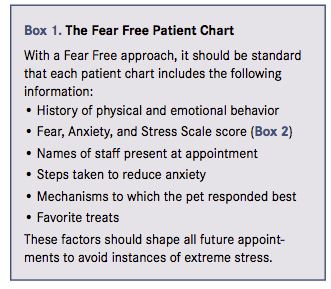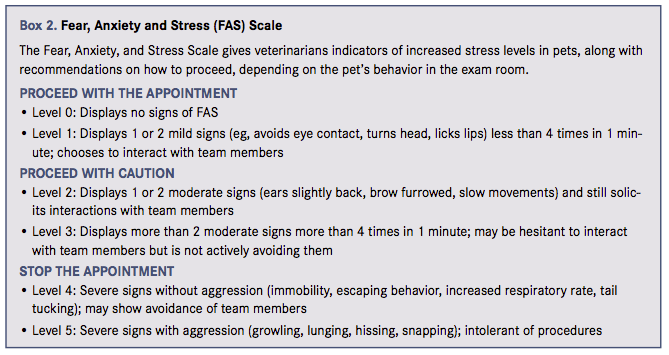Fear Free Basics
Rethinking your approach to the physical exam and incorporating some simple changes can have a monumental effect on patient and owner stress during visits.

“Fear Free” might seem like a new catchphrase, but it captures an idea long held by many veterinarians. “As veterinary behaviorists, we have been lecturing about Fear Free under different names for 20 years,” said Lisa Radosta, DVM, DACVB, owner of Florida Veterinary Behavior Service in West Palm Beach. “Now it’s an actual movement that is organized and structured, and it has taken hold of veterinary medicine.”
With Fear Free—which promotes regular visits with patients in an environment that eliminates fear, anxiety, and stress—veterinarians are rethinking their approach to pet examinations and transforming the patient-client appointment experience.
“The emotional and mental [states] of our patients are finally becoming recognized and valued as equally important as their physical health,” said Julie Shaw, RVT, VTS (Behavior), owner and director of Stepping Stone Animal Training, LLC, in Lafayette, Indiana.
RELATED:
- The Fear Free Initiative: Happy Pets Are Just Good Business
- Fear Free Demonstration: Techniques & Props
Some pets associate extreme fear with veterinary practices, and the anxiety sets in long before an exam begins. That’s why the Fear Free experience originates at the pet’s home and extends to nearly every facet of a veterinary practice.
To truly adopt the Fear Free mindset, it’s recommended that all veterinary staff members complete the Fear Free Certification Program, which covers the background of the initiative and demonstrates each employee’s role in creating a relaxing and positive atmosphere for pets. To date, more than 11,000 veterinary professionals have become Fear Free certified.
If you’re not ready to commit to the comprehensive course quite yet, you can easily incorporate a number of low-cost Fear Free basics into your veterinary practice.
Reimagine the Examination

A patient’s fear and anxiety typically culminate during the physical exam. Veterinarians may struggle with an aggressive or fractious pet, increasing the risk of injury to the pet and everyone else in the room. This is why it’s vitally important that veterinarians and veterinary technicians rethink how exams are conducted.
Slip-Free Surfaces
Being removed from its carrier and placed on a cold metal table can be terrifying for a pet, so always use slip-free surfaces, such as blankets or rubber mats. Veterinarians are also becoming increasingly open to alternative exam locations, such as on the floor or in the pet owner’s lap.
Cat Carriers
Dr. Radosta recommends leaving stressed pets, especially cats, inside their carriers throughout the examination. If that’s not possible, remove the top, rather than tipping the carrier or straining to pull out the cat. This may take a minute or 2 more, but the exam will go much more smoothly.
New Environment
Sometimes a pet may need to be removed from the exam room altogether. Shaw recounted an experience with a young dog that was too fearful even to be touched. After spending a considerable amount of time trying to work with the dog, someone on the veterinary team suggested taking the dog outside— and that changed everything. The dog was suddenly happier and much more receptive to being examined outdoors.
Consider the Senses
A dog possesses up to 300 million olfactory receptors in its nose, and the part of the canine brain that is devoted to analyzing smells is 40 times larger than that in humans. It’s not unlikely, then, that the smells in a veterinary office could affect a pet’s demeanor.
For starters, Shaw said, veterinarians and staff should refrain from applying heavily scented lotions and perfumes (although deodorant is encouraged) that a dog will pick up on immediately. Smokers should remove lab coats before cigarette breaks and wash their hands thoroughly upon returning to work.
On the other hand, using calming scents can sway a pet’s experience toward the positive. Products that mimic the naturally calming pheromones in cats and dogs are widely used throughout Fear Free veterinary practices through diffusers and as topical sprays. “Our staff is trained to spray themselves twice a day,” Shaw said. While a pet waits to be examined, spray a towel with a pheromone product, such as Feliway for cats, and place it with the animal or over the carrier to initiate stress reduction.
As a veterinary office grows busier throughout the day, staff may become immune to background noises that can upset their patients, especially animals in recovery. Slamming doors, barking dogs, and general chatter will add to the stress of an already anxious animal. To combat this, Shaw recommends playing classical music near the cages of boarded animals and in exam rooms. You can choose from a line of portable speakers and musical collections created specifically for pets at iCalm.
Make Positive Associations
Animals are motivated by food, so Fear Free encourages veterinarians to offer treats—Shaw calls them “dog money”—throughout the exam. Begin by laying treats near a pet or by the carrier to create a positive initial impression without getting too close when you enter the room.
Treats also make a great distraction tool. Shaw recommends smearing peanut butter on the wall or table so a dog focuses on lapping up the treat rather than on what the veterinarian is doing

Both cats and dogs are food motivated, so offering treats is a great way to relieve patient stress and anxiety during veterinary visits.
during the examination. “Fear Free actually shows that it’s OK for dogs to have a little food before a procedure,” Shaw said. “It’s better for them.”
She also recalled a Fear Free video of 2 technicians who took a unique approach to removing sutures from a dog by using food to divert attention. One technician remained near the dog’s head and offered treats, and the other laid on the floor and took out the stitches upside down. “That’s exactly what you should be doing,” Shaw added. “Make sure the patient feels secure.”
Eliminate the Waiting Room
Shaw stated it simply: “Waiting rooms are for humans, not dogs or cats. I don’t think pets should be in waiting rooms, because it causes stress.”
Dr. Radosta shares that sentiment. Whenever possible, she said, her staff moves a patient from the waiting room directly into an empty exam room, explaining to the client that although the doctor won’t be in right away, the private room is better for the stressed pet.
Practices that don’t have empty rooms to spare can get creative. Dr. Radosta sometimes instructs clients with fearful pets to wait in the car. “We [can] text right through our messaging system: ‘Your exam room is ready—come on in,’” she said.
Becoming resourceful may mean having a patient wait in an empty hallway or setting up a chair behind the reception desk away from other patients, Shaw said. For long-term solutions, veterinary offices can incorporate barriers—say, a row of plants—to separate waiting patients and install shelves or platforms for carriers to keep cats off the floor and out of the way.

Create a Plan of Action
As Shaw pointed out, 2 of the most important aspects of Fear Free are knowing what to do next and planning for the future. A veterinarian who recognizes the signs of increased anxiety in an animal should already have a plan for what can be done immediately to calm the pet.
“Does it mean going into a different room? Does it mean covering the dog’s eyes?” Shaw asked. “[It means] whatever it’s going to take at that moment to decrease what is happening [with that pet].”
That might even mean halting the exam entirely. “Say to the owner, ‘Take home this gabapentin, take home this Feliway, and please come back in a week,’” Dr. Radosta said. “It’s not a matter of what I can do today, it’s a matter of what I should do ethically for your cat.” That’s what is most important, she added.
Work With Pet Owners
Some pets, especially cats, never make it to the veterinary office due to the owner’s perception of the pet’s reaction to the visit, as well as the client’s own stress about dealing with the situation, Dr. Radosta said. Fear Free addresses both factors by including clients in the stress-reduction process.
For example, if the sight of a carrier sparks an instant negative reaction, the client should help the pet become familiar with it at home. The veterinarian should instruct the owner to leave the carrier out regularly so the animal becomes comfortable around it, rather than associating it only with frightening experiences.
Additionally, a veterinarian might recommend spraying pheromones on a towel and placing it in the carrier with the pet while traveling to the clinic. Fear Free also suggests that pet owners limit food prior to an appointment, increasing the effectiveness of treats as rewards, and bring the pet’s favorite treats to the visit.
Veterinarians need to talk with clients about the known signs of pet anxiety (eg, excessive licking, tucked tail, or visible tension) and how to detect these signs early. Engaging pet owners in the Fear Free experience and providing them with easy solutions and guidance creates a harmonious approach to pet care that can make clients comfortable.
“We can’t provide the best medical care if they don’t show up,” Dr. Radosta said. “Fear Free is going to be the tidal wave that pushes them into the practice.”
